
Ralfsia fungiformis
Sea Fungus, Fungal Crust Seaweed
28 May 2025
Big Beach, Vancouver Island, B.C., Canada.
Tide: - 0.3 foot low at 08:16am PDT (measured at Ucluelet Tidal Station)
Weather: Mostly clear, wind variable 5 - 10 km/hour, sea light chop, moderate westerly swell, humidity 81%, 15 ˚C.
Moon: Waxing Crescent, (4.1%, 2 days); Next phase, First Quarter, 2 June 2025 at 8:40pm PDT; Previous phase, New Moon, 26 May 2025 at 8:02pm PDT.
and:
29 May 2025
Florencia Bay Beach, Vancouver Island, B.C., Canada.
Tide: 0.0 foot low at 9:22am PDT (measured at Tofino Tidal Station)
Weather: Mostly clear, wind WNW 5 - 10 km/hour, sea rippled, low westerly swell, humidity 82%, 12 ˚C.
Moon: Waxing Crescent (9.2%, 3 days); Next phase, First Quarter, 2 June 2025 at 8:40pm PDT; Previous phase, New Moon, 26 May 2025 at 8:02pm PDT.
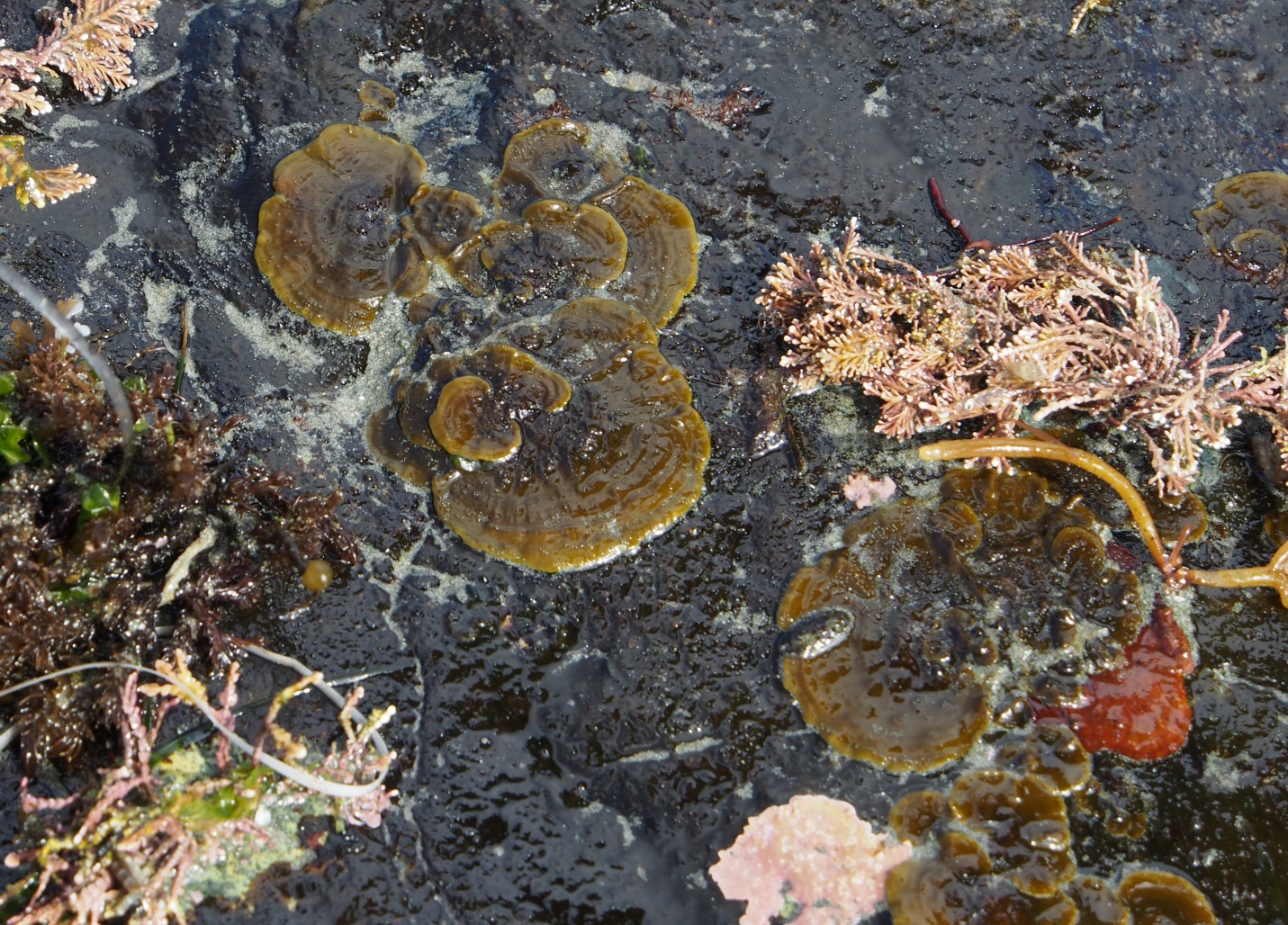
Figure 1: Pictured here are several lobes of Ralfsia fungiformis. Other algae also share space on this rock that was embedded at the end of a sandy beach. The concentric ‘growth rings’ can be seen and indicate previous growth. The lighter colored and ‘lifted up’ from the substrate outer margins are the newest growth of this seaweed. Florencia Bay, Vancouver Island, B.C. Canada. May 29, 2025. Photo ID 27804 ©Seaweedwhisperings.com
Person 1:
Often has the appearance of brownish fungi that have multiple, somewhat overlapping fruiting bodies. Gives the sense of fast-growing, slightly out of control energy. But seems to regain control and form distinctive organized edges to the growth.
Brownish to brown-gold coloration is unusual for an alga. Seemingly like a surface that was once brilliant, but now mellowed and softly-weathered with age. Not rotten, but certainly not at its prime.
I recall on one occasion, seeing Ralfsia fungiformis underwater in a tidal outflow stream. It looked like it was enjoying playing with the light. As the stream ripples flowed over it, the coppery coloration dazzled momentarily with glimpses of brilliance, then retreated to dullness.
Perhaps Ralfsia fungiformis spends too much time reminiscing about the past, maybe not taking enough care to thrive in the present.
Teasing.
Peak under my skirt?
But won’t show much.
A bit rambunctious, climbing all over each other playfully.
There’s certainly a touch of hesitancy in its being..., sometimes confident, but often in a mode of retreat.
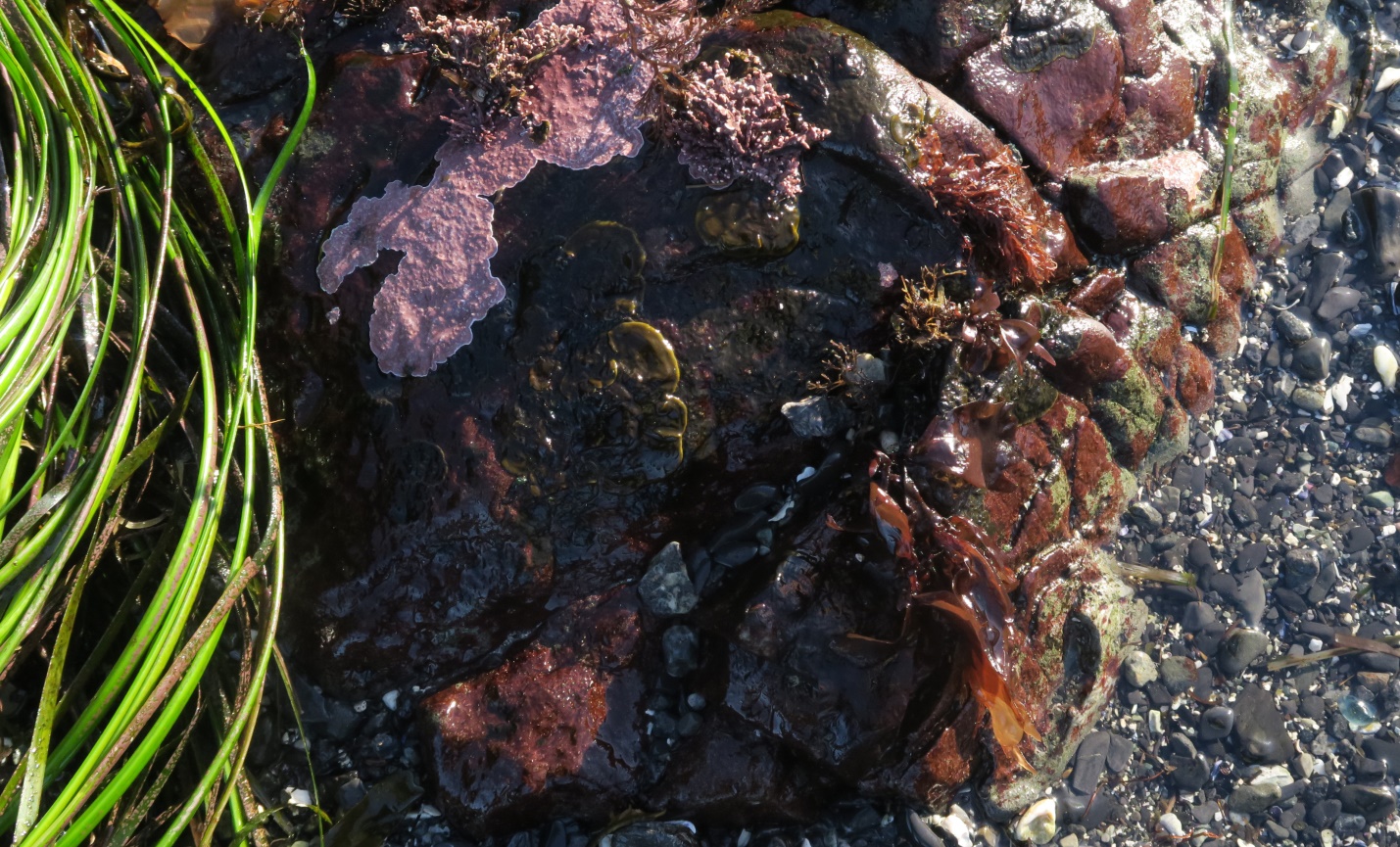
Figure 2: On a low intertidal boulder several algal crust species make their home. The early morning light casts strong shadows, but the deep red of Hildenbrandia is obvious as is the lighter pink of the coralline algae. In just about the exact center of this image our focus species, Ralfsia fungiformis, is visible. The eye picks up the lighter golden brown margins that ring this unusual seaweed. This seaweed has a more earthy quality in general and it chooses not to be showy. Big Beach, Vancouver Island, B.C. Canada. May 28, 2025. Photo ID 27805 ©Seaweedwhisperings.com
Person 2:
We don’t find you often, Ralfsia, so it is always a bit special to encounter you. It’s a bit like looking for wild mushrooms in the forest – you know they could be in the area, but where you’ll actually encounter them is a bit of an unknown.
Your species name, “fungiformis”, certainly hints at the fungus aspect. The similarity is visual, and it is to the tree fungi that have ‘growth’ rings like members of the Ganoderma genus. So you are not like a puffball – a single season mushroom wonder, you are something that’s been around for a while and has past history marked in you.
Your newest edges are
a lighter golden color compared to your darker brown older self and
they are lifted up, Ralfsia,
almost like you need to put a bit of color on and really “step up”
in order to move forward and get larger. And really it seems from
your older self that you prefer to hug quite tightly the rocks that
you grow on. There is a kind of half wanting to stay with the
familiarity and known aspects of what you’ve already accomplished,
and a half wanting to move out a bit to something a bit new. It
seems, actually, Ralfsia
fungiformis,
that you do both.
It is at these edges, the margins where new
growth is manifest adjacent to old, that the energy of Ralfsia
is the most interesting.
You do grow on rocks low in the intertidal and your shape and color somehow don’t always stand out that much. One time we found you growing adjacent to other rock crusts, one the rich red Hildenbrandia, and the other some bright pink corallines, and if it weren’t for your distinctive texture and your lighter colored new growth margins, you’d almost be missed. It’s almost like you want to be very ‘organic’ in your nature – that you are most content being truly a part of your environment and made up wholly from the very elements of it.
You tend to grow in groupings and the different ‘circles’ of individual Ralfsia can overlap each other, too. There is a wee bit of a spilling over feeling at these points; it really seems like you don’t have quite enough space. You can’t shrink back and still grow, so you lift up your edges and spill over whatever is nearby. There’s almost awkwardness to this, and perhaps you’re even a bit apologetic about the encroachment on others. You only know one main direction to grow and it is outward. Retreating or shrinking is not growth, and growing upwards is not your style, so when space is limited, this trespass, infringement and spilling over is inevitably going to happen.
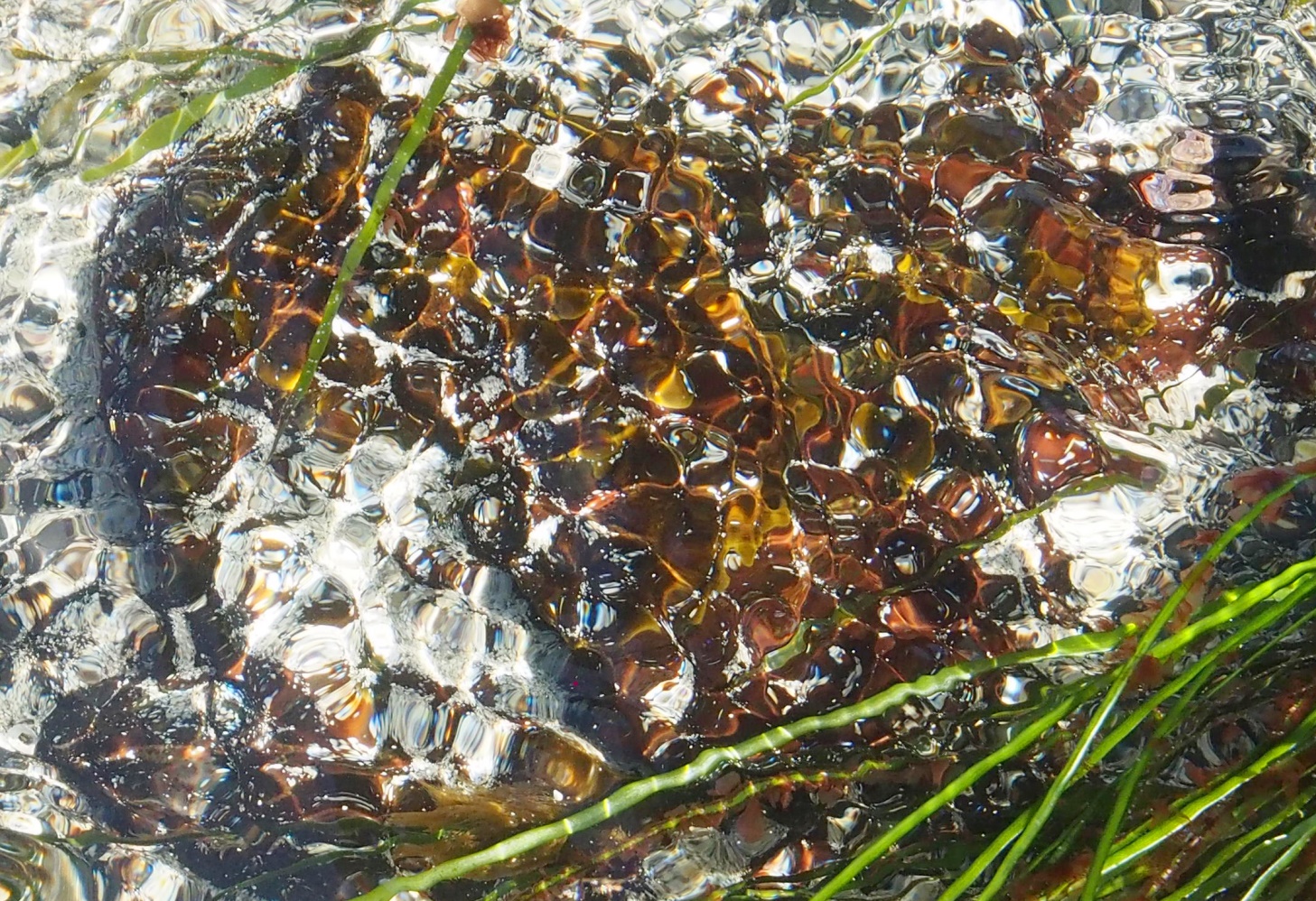
Figure 3: On an early May day and at a retreating tide, the tidal outflow stream here is running steadily over this cobble. The pictured rock is surrounded by sand and white shell fragments and is covered in several groupings of Ralfsia fungiformis. The play of light on the moving water distorted the form of this marine alga but enhanced the coloration – copper and brass are inherent. Big Beach, Vancouver Island, B.C. Canada. May 11, 2024. Photo ID 27806 ©Seaweedwhisperings.com
Discussion:
There is an “earthy” quality to this seaweed; it seems to be constructed of elemental components at their basic level, and observing Ralfsia fungiformis leaves one wondering if it is coming into manifestation from those elements or if it is retreating into the background.
Recalling the tidal outflow stream and the play of light on the groupings of Ralfisia that Person 1 noted, we considered the coloration more fully. “Was the coloration ‘coppery’? Because the description could possibly also include ‘brassy’.” Yes, we both thought, like brass, a warm brassy color.
We checked some definitions and color samples and agreed that “brass” fits the overall energy of this seaweed as well as being an apt description of parts of its coloration. Brass color is a warm metallic hue reminiscent of the brass alloy; typically it is a shade of golden-yellow with subtle undertones, sometimes appearing slightly muted or aged.
The glimpses of brilliance that dazzled..., possibly these arise from the “elements” it is made of. Brass is an alloy comprised mainly of Copper and Zinc, with lead, aluminum and manganese sometimes used to attain certain characteristics. The largest single element in the alloy is Copper, and it is interesting that this “shows through” when Ralfsia ‘plays with light’.
Playfulness was noted in the idea of “peak under my skirt” and some rambunctious climbing over each other, too. There is a bit of the hesitation mixed in with this play, however, as if there’s some doubt about how far to indulge or how it will turn out.
The muted or aged aspect shows up also with the concentric growth marks on the lobes of this seaweed. The growth of Ralfsia fungiformis is much slower than most other macro algae; not as slow as the red rock crust Hildenbrandia, but compared to the cheetah-like speed of Bull Kelp (Nereocystis luetkeana) it is certainly sloth-like. Where there is any speed or extra energy or spilling over of energy that is not yet quite organized and settled, this is at the margins. These margins free from the substrate (not firmly attached like the older parts of the seaweed) are where the most liveliness is expressed. And even here, the choice of color is for a muted undertone rather than a bold and sparkling tone. This seaweed is content with that which others might find a bit musty or moldy or tarnished and weathered. They see beauty in this, or perhaps more accurately ‘character’, as it is suggestive of a ‘history’, it indicates there are stories ‘from before’ that informs the type of color or degree of polish. Perhaps this is why they are slower – they carry all this history with them. And aspects of the past are ones they appreciate and would truly long for were they lost and gone. So they don’t mind lingering there a bit, going slower, or maybe sometimes staying where they are – it can be satisfyingly quite enough.
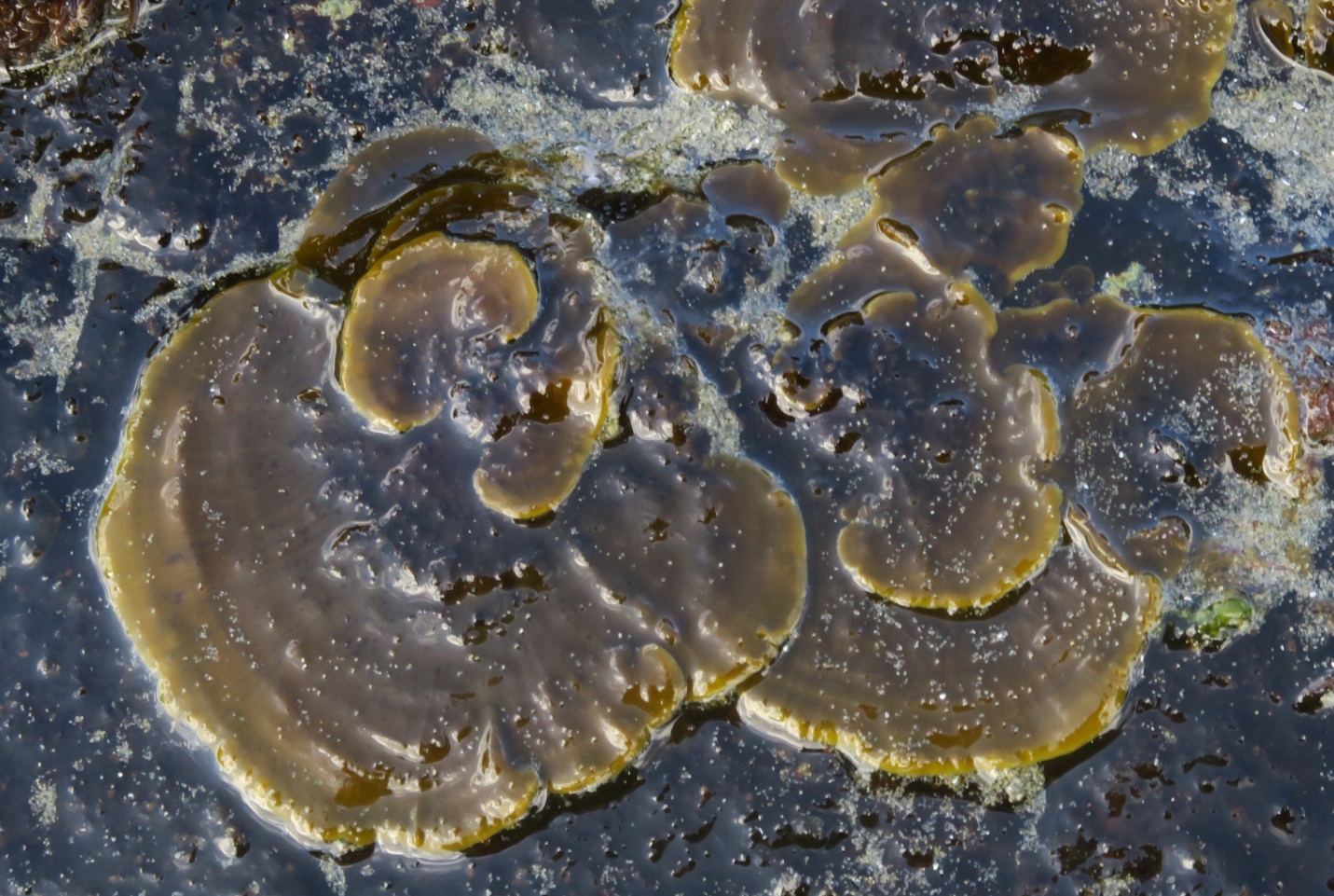
Figure 4: A closer view of some lobes of Ralfsia fungiformis show the overlapping and lifted margins that distinguish this seaweed. These brassy colored margins are where all the ‘action’ is at for this seaweed and the burst of growth that formed them will leave a mark, as can be seen in the concentric rings closer to the center of the lobes. Florencia Bay, Vancouver Island, B.C. Canada. May 29, 2025. Photo ID 27807 ©Seaweedwhisperings.com
Biology & Natural History Information:
Description:
The thallus of this species resembles a fungus, with distinctive broadly overlapping coriaceous crustose lobes that are olive to dark brown; the margins are brown to yellowish in color and are free of the substrate. The growth habit of the thalli is of nearly circular patches. They make use of tiny, root-like rhizoids to affix themselves loosely to the substrate. These ‘fungal’ crusts are typically about 1 mm thick (although their lifted somewhat wavy margins give an impression of greater thickness) and grow between 2 and 6 cm in diameter. A slow growing perennial, concentric and radial growth lines are visible on the lobes.
Habitat:
Frequent on rock in the mid to low intertidal, including tide pools; prefers protected to semi-exposed habitats. It is widely distributed in the colder waters of the northern hemisphere. The type locality for this species is Iceland (Gunnerus), the North Atlantic.
North Pacific Distribution:
Bering Sea and Aleutian Islands, Alaska, to Humboldt County, California; Arctic; Korea; Japan; Russia.
Remarks:
Studies in Washington state have shown that this species grows by only about 13 mm in diameter annually. The scientific name for the species, fungiformis, was chosen to describe its resemblance to species of fungus of the terrestrial world.
Classification:
Empire: Eukaryota
Kingdom: Chromista
Phylum: Heterokontophyta
Subphylum: Ochrophytina
Class: Phaeophyceae
Subclass: Fucophycidae
Order: Ralfsiales
Family: Ralfsiaceae
Genus: Ralfsia
Species: Ralfsia fungiformis (Gunnerus) Setchell & N.L.Gardner 1924
Former names:
Fucus fungiformis Gunnerus 1766; Ralfsia deusta (C.Agardh) Berkeley 1843.
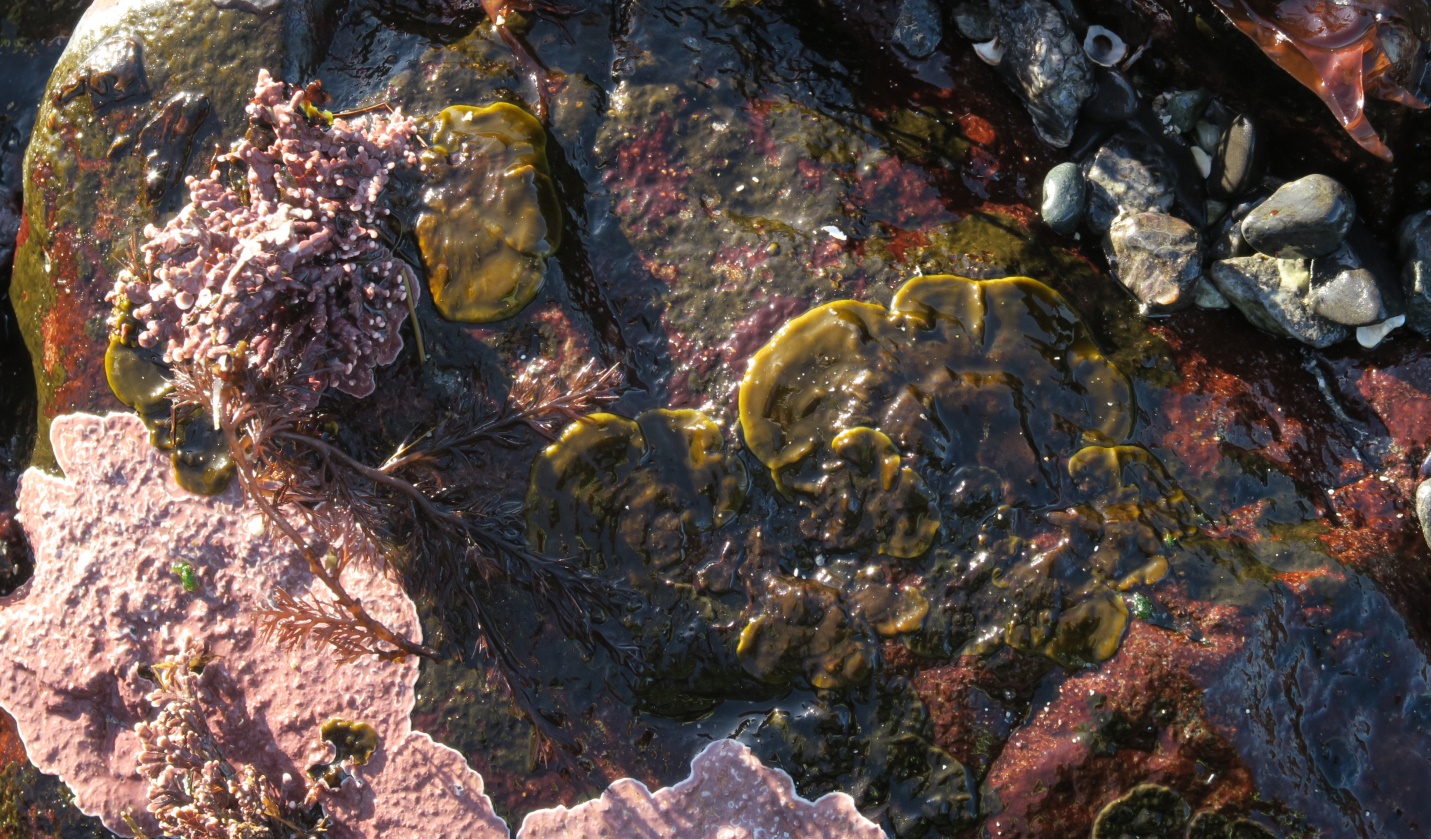
Figure 5: The Ralfsia fungiformis growing on this rock is competing with other algal crusts for habitat. It grows slowly and seems to overtake new space with a bit of hesitation. Big Beach, Vancouver Island, B.C. Canada. May 28, 2025. Photo ID 27808 ©Seaweedwhisperings.com
![]()